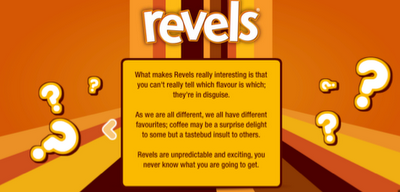When learning about probability we use Revels.
Yes, the chocolates. The whole brand of Revels is about which flavour you will
eat, the likelihood of getting one you don't like and hoping for your
favourite. That's probability in the 'real world' of a Key Stage Two child!
Step one is to introduce the children to the
language of probability and particularly why it's important to be careful when
using 'certain', 'impossible' or 'even chance'. Do 'Play Your Cards Right',
coin toss and other examples if needed. Then go back to discuss the likelihood
of getting a certain flavour when selecting a Revel. We found the children
expected there would be equal chances of picking out each flavour. We have used
some of the Revels TV commercials to further explain the marketing behind this
product:
We placed a packed of revels on each table to be
shared between 6 to 8 children. Now, in order to be able to state the
probability of getting a certain flavour we need to find out if the Revel
flavours are evenly distributed. Well, there's only one way to find out! Next,
comes eating and tallying. The children eat the revels and tally the total
amount of each flavour eaten.
Gather the information from each table about how
many of each flavour were in their packs. This now offers the opportunity to
calculate some averages. For example, Toffee: 7, 8, 9, 9, 14. From this data
the mean, median, mode and range for each flavour per packet can be calculated,
then maybe even converted into percentages.
It now becomes apparent that the spread of
flavours is NOT equal and in fact quite consistently biased towards one
flavour! In addition to this the range can be quite broad from one packed to
another. After looking at the data and discussing what it shows we wrote letters
to Mars (address is on the packet) and hope to get a response from them. The
letters offered a link to our persuasive writing topic and involved the
children needing to include data to back up their arguments.
A fun filled lesson or two. The children learned
a lot about probability and also had the opportunity to write to a real company
about their findings.
Image credits: www.revels.co.uk

